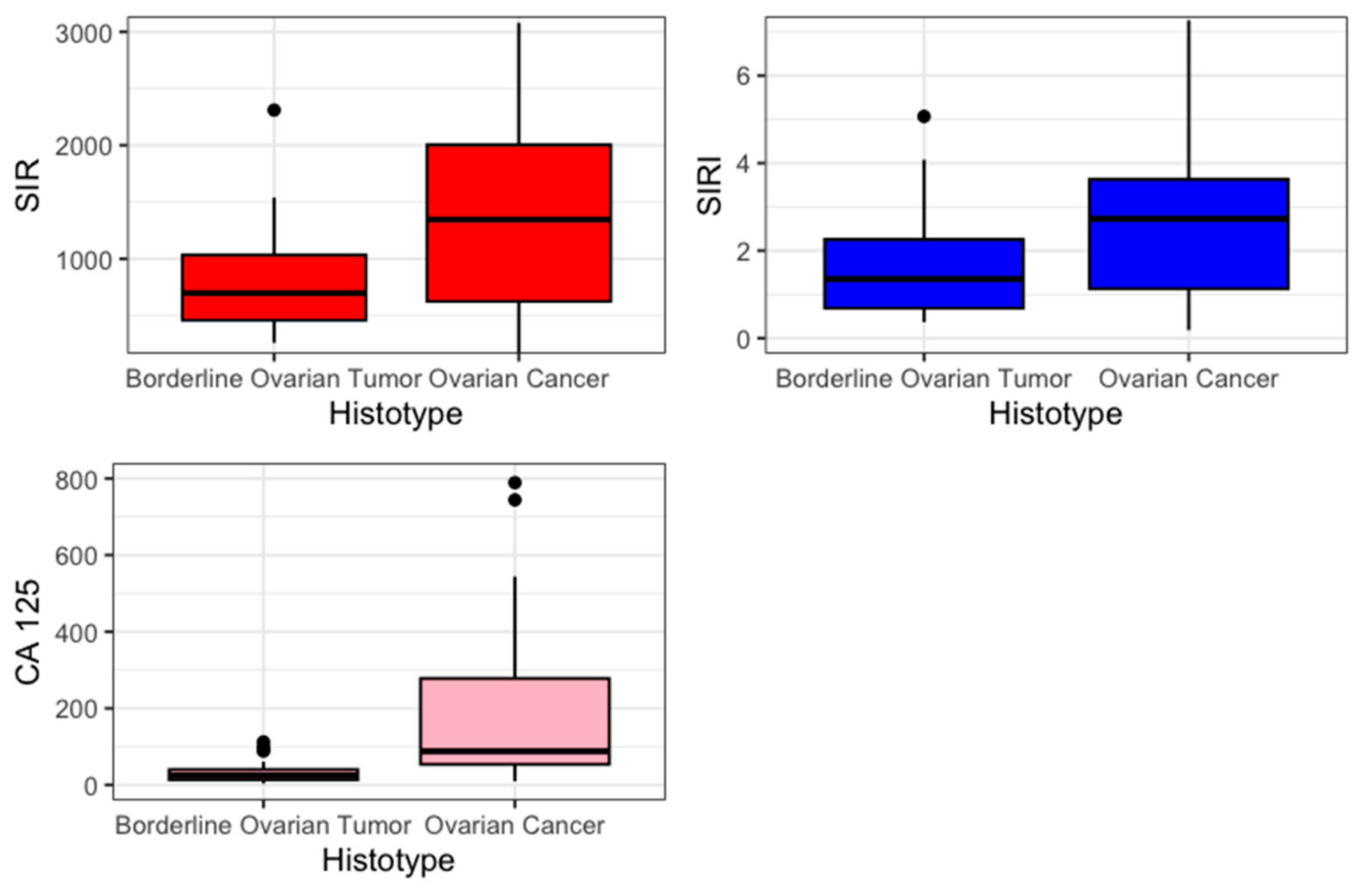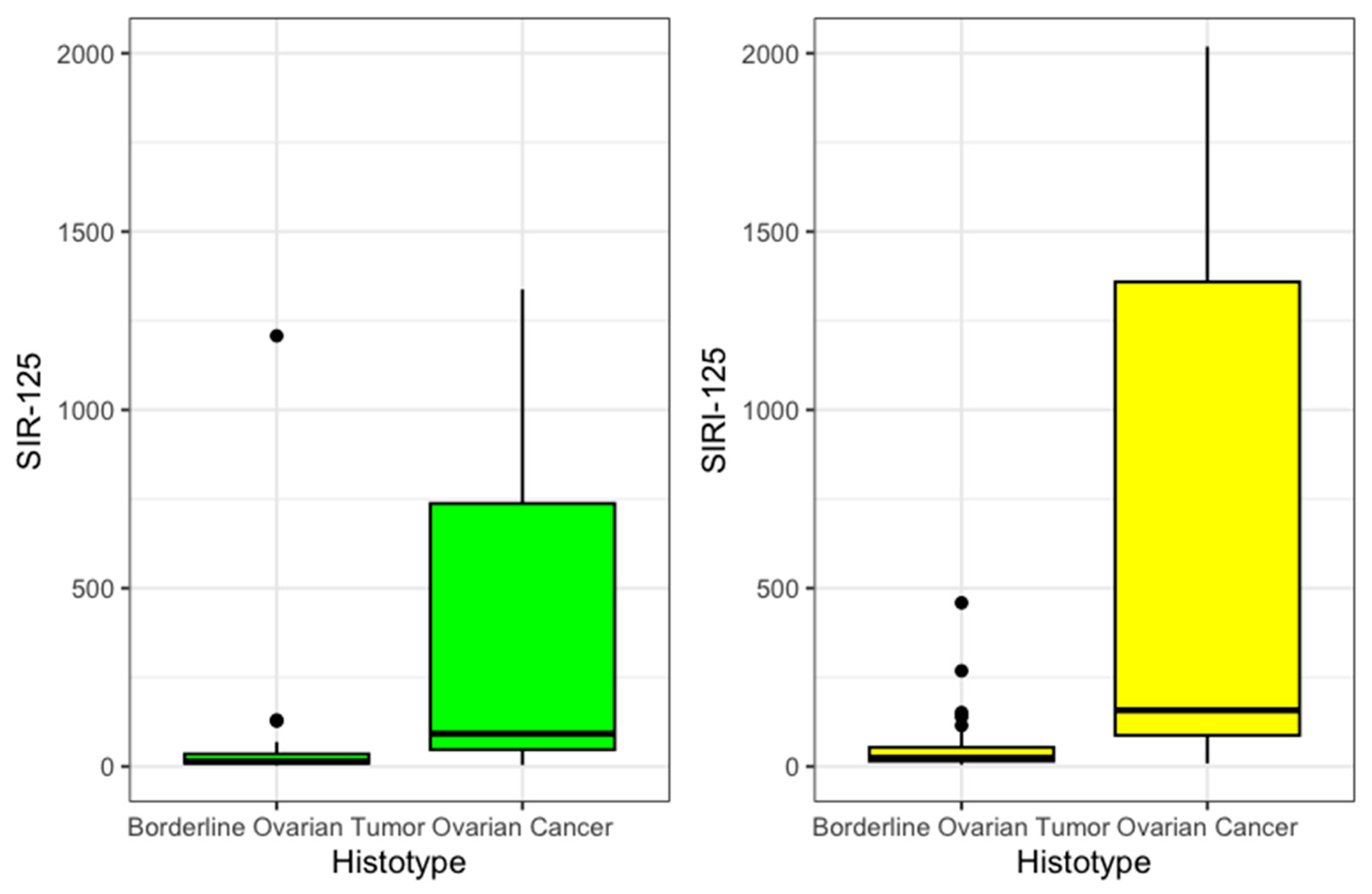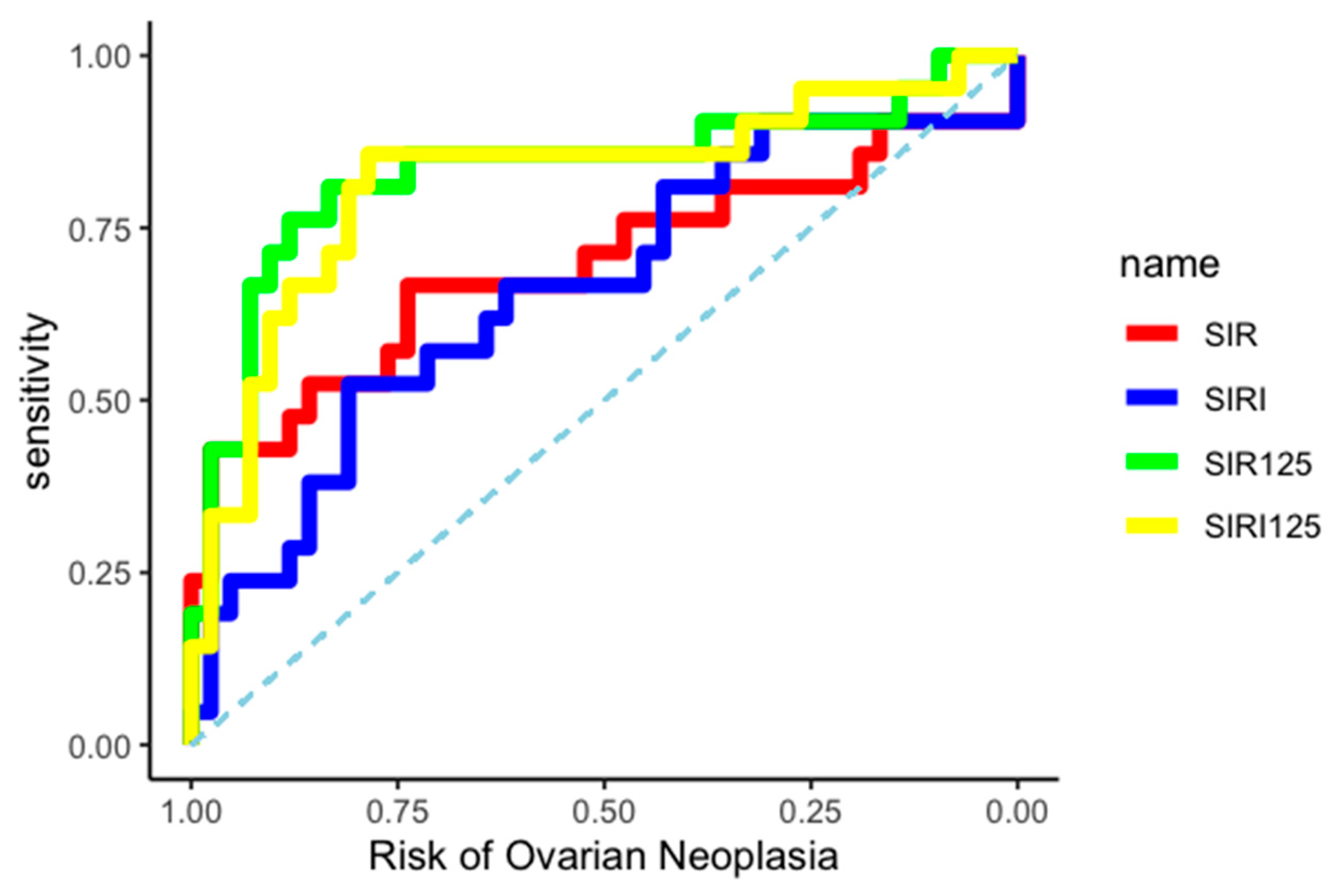Inflammatory Indices and CA 125: A New Approach to Distinguish Ovarian Carcinoma and Borderline Tumors in Suspicious Ovarian Neoplasms from a Retrospective Observational Multicentric Study
Abstract
1. Introduction
Objective
2. Materials and Methods
2.1. Study Design
2.2. Setting
2.3. Participants
2.4. Variables
2.5. Laboratory
2.6. Statistical Analysis
2.7. Risk of Bias
3. Results
3.1. Outcomes
3.2. Logit Regression
3.3. ROC Curve
4. Discussion
4.1. Interpretation of Results
4.2. Comparison with Existing Literature
4.3. Clinical Implication
4.4. Strengths and Limitations
5. Conclusions
Supplementary Materials
Author Contributions
Funding
Institutional Review Board Statement
Informed Consent Statement
Data Availability Statement
Acknowledgments
Conflicts of Interest
Abbreviations
| AUC | Area Under the Curve |
| ADNEX | Assessment of Different NEoplasias in the adneXa |
| ART | Assisted Reproductive Technology |
| BIC | Bayesian Information Criteria |
| BMI | Body Mass Index |
| BOT | Borderline Ovarian Tumor |
| CA 125 | Cancer Antigen 125 |
| CT | Computed Tomography |
| ECLIA | Electrochemiluminescence Immunoassay |
| FIGO | International Federation of Gynecology and Obstetrics |
| HGSOC | High-Grade Serous Ovarian Cancer |
| IOTA | International Ovarian Tumor Analysis |
| IRB | Institutional Review Board |
| LGSOC | Low-Grade Serous Ovarian Cancer |
| MRI | Magnetic Resonance Imaging |
| NK | Natural Killer (cells) |
| NPV | Negative Predictive Value |
| OC | Ovarian Carcinoma |
| O-RADS MRI | Ovarian–Adnexal Reporting Data System Magnetic Resonance Imaging |
| PET | Positron Emission Tomography |
| PPV | Positive Predictive Value |
| ROC | Receiver Operating Characteristic |
| SIRI | Systemic Inflammation Response Index |
| SIR | Systemic Inflammatory Response |
| SIR-125 | Systemic Inflammatory Response combined with CA 125 |
| SIRI-125 | Systemic Inflammation Response Index combined with CA 125 |
| STROBE | Strengthening the Reporting of Observational Studies in Epidemiology |
References
- Liberto, J.M.; Chen, S.Y.; Shih, I.M.; Wang, T.H.; Wang, T.L.; Pisanic, T.R., 2nd. Current and Emerging Methods for Ovarian Cancer Screening and Diagnostics: A Comprehensive Review. Cancers 2022, 14, 2885. [Google Scholar] [CrossRef] [PubMed] [PubMed Central]
- Rampes, S.; Choy, S.P. Early diagnosis of symptomatic ovarian cancer in primary care in the UK: Opportunities and challenges. Prim Health Care Res. Dev. 2022, 23, e52. [Google Scholar] [CrossRef] [PubMed] [PubMed Central]
- Timmerman, D.; Valentin, L.; Bourne, T.H.; Collins, W.P.; Verrelst, H.; Vergote, I.; International Ovarian Tumor Analysis (IOTA) Group. Terms, definitions and measurements to describe the sonographic features of adnexal tumors: A consensus opinion from the International Ovarian Tumor Analysis (IOTA) Group. Ultrasound Obstet. Gynecol. Off. J. Int. Soc. Ultrasound Obstet. Gynecol. 2000, 16, 500–505. [Google Scholar] [CrossRef]
- Guerriero, S.; Saba, L.; Alcazar, J.L.; Pascual, M.A.; Ajossa, S.; Perniciano, M.; Piras, A.; Sedda, F.; Peddes, C.; Fabbri, P.; et al. Past, present and future ultrasonographic techniques for analyzing ovarian masses. Women’s Health 2015, 11, 369–383. [Google Scholar] [CrossRef] [PubMed]
- Timmerman, D.; Ameye, L.; Fischerova, D.; Epstein, E.; Melis, G.B.; Guerriero, S.; Van Holsbeke, C.; Savelli, L.; Fruscio, R.; Lissoni, A.A.; et al. Simple ultrasound rules to distinguish between benign and malignant adnexal masses before surgery: Prospective validation by IOTA group. BMJ 2010, 341, c6839. [Google Scholar] [CrossRef] [PubMed]
- Thomassin-Naggara, I.; Poncelet, E.; Jalaguier-Coudray, A.; Guerra, A.; Fournier, L.S.; Stojanovic, S.; Millet, I.; Bharwani, N.; Juhan, V.; Cunha, T.M.; et al. Ovarian-Adnexal Reporting Data System Magnetic Resonance Imaging (O-RADS MRI) Score for Risk Stratification of Sonographically Indeterminate Adnexal Masses. JAMA Netw. Open 2020, 3, e1919896. [Google Scholar] [CrossRef]
- Van Calster, B.; Van Hoorde, K.; Valentin, L.; Testa, A.C.; Fischerova, D.; Van Holsbeke, C.; Savelli, L.; Franchi, D.; Epstein, E.; Kaijser, J.; et al. Evaluating the risk of ovarian cancer before surgery using the ADNEX model to differentiate between benign, borderline, early and advanced stage invasive, and secondary metastatic tumours: Prospective multicentre diagnostic study. BMJ 2014, 349, g5920. [Google Scholar] [CrossRef]
- Prat, J.; FIGO Committee on Gynecologic Oncology. Staging classification for cancer of the ovary, fallopian tube, and peritoneum. Int. J. Gynaecol. Obstet. Off. Organ Int. Fed. Gynaecol. Obstet. 2014, 124, 1–5. [Google Scholar] [CrossRef]
- Trimble, C.L.; Trimble, E.L. Management of epithelial ovarian tumors of low malignant potential. Gynecol. Oncol. 1994, 55 Pt 2, S52–S61. [Google Scholar] [CrossRef]
- Colombo, N.; Sessa, C.; du Bois, A.; Ledermann, J.; McCluggage, W.G.; McNeish, I.; Morice, P.; Pignata, S.; Ray-Coquard, I.; Vergote, I.; et al. ESMO-ESGO consensus conference recommendations on ovarian cancer: Pathology and molecular biology, early and advanced stages, borderline tumours and recurrent disease. Ann. Oncol. Off. J. Eur. Soc. Med. Oncol. 2019, 30, 672–705. [Google Scholar] [CrossRef]
- Bozdag, H.; Guzin, K.; Gocmen, A.; Kabaca, S.; Usta, A.; Akdeniz Duran, E. The diagnostic value of frozen section for borderline ovarian tumours. J. Obstet. Gynaecol. J. Inst. Obstet. Gynaecol. 2016, 36, 626–630. [Google Scholar] [CrossRef] [PubMed]
- Zhang, W.; Zhang, Z.; Qian, L. Prognostic and clinicopathological significance of C-reactive protein in patients with ovarian cancer: A meta-analysis. World J. Surg. Oncol. 2024, 22, 8. [Google Scholar] [CrossRef]
- Meng, L.; Yang, Y.; Hu, X.; Zhang, R.; Li, X. Prognostic value of the pretreatment systemic immune-inflammation index in patients with prostate cancer: A systematic review and meta-analysis. J. Transl. Med. 2023, 21, 79. [Google Scholar] [CrossRef] [PubMed]
- Fest, J.; Ruiter, R.; Mulder, M.; Groot Koerkamp, B.; Ikram, M.A.; Stricker, B.H.; van Eijck, C.H.J. The systemic immune-inflammation index is associated with an increased risk of incident cancer-A population-based cohort study. Int. J. Cancer 2020, 146, 692–698. [Google Scholar] [CrossRef] [PubMed] [PubMed Central]
- Vandenbroucke, J.P.; von Elm, E.; Altman, D.G.; Gøtzsche, P.C.; Mulrow, C.D.; Pocock, S.J.; Poole, C.; Schlesselman, J.J.; Egger, M. Strengthening the reporting of observational studies in epidemiology (STROBE): Explanation and elaboration. PLoS Med. 2007, 4, e297. [Google Scholar] [CrossRef] [PubMed]
- Garlisi, B.; Lauks, S.; Aitken, C.; Ogilvie, L.M.; Lockington, C.; Petrik, D.; Eichhorn, J.S.; Petrik, J. The Complex Tumor Microenvironment in Ovarian Cancer: Therapeutic Challenges and Opportunities. Curr. Oncol. 2024, 31, 3826–3844. [Google Scholar] [CrossRef] [PubMed] [PubMed Central]
- Lior, C.; Barki, D.; Halperin, C.; Iacobuzio-Donahue, C.A.; Kelsen, D.; Shouval, R.S. Mapping the tumor stress network reveals dynamic shifts in the stromal oxidative stress response. Cell Rep. 2024, 43, 114236. [Google Scholar] [CrossRef]
- Le Bitoux, M.A.; Stamenkovic, I. Tumor-host interactions: The role of inflammation. Histochem. Cell Biol. 2008, 130, 1079–1090. [Google Scholar] [CrossRef]
- Ronsini, C.; Iavarone, I.; Vastarella, M.G.; Della Corte, L.; Andreoli, G.; Bifulco, G.; Cobellis, L.; De Franciscis, P. SIR-EN-New Biomarker for Identifying Patients at Risk of Endometrial Carcinoma in Abnormal Uterine Bleeding at Menopause. Cancers 2024, 16, 3567. [Google Scholar] [CrossRef]
- Ronsini, C.; Iavarone, I.; Braca, E.; Vastarella, M.G.; Della Corte, L.; Vitale, C.; Andreoli, G.; La Mantia, E.; Cobellis, L.; de Franciscis, P. Deep Myometrial Infiltration leads to a measurable Inflammatory Response in Endometrial Cancer. A Prospective Observational Study. Semin. Oncol. 2024, 51, 149–153. [Google Scholar] [CrossRef]
- Blanc-Durand, F.; Clemence Wei Xian, L.; Tan, D.S.P. Targeting the immune microenvironment for ovarian cancer therapy. Front. Immunol. 2023, 14, 1328651. [Google Scholar] [CrossRef] [PubMed]
- Lucidi, A.; Buca, D.; Ronsini, C.; Tinari, S.; Bologna, G.; Buca, D.; Leombroni, M.; Liberati, M.; D’Antonio, F.; Scambia, G.; et al. Role of Extracellular Vesicles in Epithelial Ovarian Cancer: A Systematic Review. Int. J. Mol. Sci. 2020, 21, 8762. [Google Scholar] [CrossRef] [PubMed]
- Yang, S.; Zhao, H.; Xiao, W.; Shao, L.; Zhao, C.; Sun, P. Extracellular vesicle-packaged miR-181c-5p from epithelial ovarian cancer cells promotes M2 polarization of tumor-associated macrophages via the KAT2B/HOXA10 axis. J. Gene Med. 2022, 24, e3446. [Google Scholar] [CrossRef] [PubMed]
- Santiago, A.E.; Paula, S.O.C.; Carvalho, A.T.; Cândido, E.B.; Furtado, R.S.; Silva Filho, A.L.D. Systemic Inflammatory Patterns in Ovarian Cancer Patients: Analysis of Cytokines, Chemokines, and Microparticles. Padrões inflamatórios sistêmicos em pacientes com câncer de ovário: Análise de citocinas, quimiocinas e micropartículas. Rev. Bras. Ginecol. Obstet. Rev. Fed. Bras. Das Soc. Ginecologia Obstetricia 2023, 45, e780–e789. [Google Scholar] [CrossRef]
- Zhang, W.W.; Liu, K.J.; Hu, G.L.; Liang, W.J. Preoperative platelet/lymphocyte ratio is a superior prognostic factor compared to other systemic inflammatory response markers in ovarian cancer patients. Tumour Biol. J. Int. Soc. Oncodevelopmental Biol. Med. 2015, 36, 8831–8837. [Google Scholar] [CrossRef]
- Lozano, C.P.; Wilkens, L.R.; Shvetsov, Y.B.; Maskarinec, G.; Park, S.Y.; Shepherd, J.A.; Boushey, C.J.; Hebert, J.R.; Wirth, M.D.; Ernst, T.; et al. Associations of the Dietary Inflammatory Index with total adiposity and ectopic fat through the gut microbiota, LPS, and C-reactive protein in the Multiethnic Cohort-Adiposity Phenotype Study. Am. J. Clin. Nutr. 2022, 115, 1344–1356. [Google Scholar] [CrossRef]



| Characteristic | Borderline Ovarian Tumor, N = 42 1 | Ovarian Cancer, N = 21 1 | p-Value 2 |
|---|---|---|---|
| Age | 51 (38, 64) | 56 (49, 63) | 0.137 |
| BMI | 23.0 (19.4, 27.6) | 25.7 (23.0, 29.3) | 0.078 |
| Missing | 2 | 0 | |
| Menopouse | 20 (48%) | 14 (67%) | 0.187 |
| Side | 0.067 | ||
| Left | 10 (24%) | 10 (48%) | |
| Right | 22 (52%) | 10 (48%) | |
| Bilateral | 10 (24%) | 1 (4.8%) | |
| Maximum Diameter | 85 (44, 150) | 108 (69, 131) | 0.570 |
| Histotype | |||
| Endometrioid BOT | 1 (2.4%) | - | |
| Serous BOT | 22 (52%) | - | |
| Mucinous BOT | 19 (45%) | - | |
| HGSOC | - | 9 (43%) | |
| LGSOC | - | 4 (19%) | |
| Clear Cell | - | 3 (14%) | |
| Endometrioid | - | 1 (4.8%) | |
| Mucinous Expansive | - | 2 (9.5%) | |
| Stromal | - | 1 (4.8%) | |
| Serum CA-125 | 25 (13, 40) | 88 (54, 278) | <0.001 |
| Neutrophils (103 units/dL) | 4.5 (3.5, 6.2) | 6.6 (4.6, 7.2) | 0.034 |
| Lymphocytis (103 units/dL) | 1.68 (1.24, 2.07) | 1.66 (1.28, 2.16) | 0.919 |
| Monocytis (103 units/dL) | 0.44 (0.35, 0.59) | 0.60 (0.52, 0.70) | 0.046 |
| Platelets (103 units/dL) | 234 (199, 276) | 300 (262, 371) | 0.003 |
| Characteristic | Borderline Ovarian Tumor, N = 42 1 | Ovarian Cancer, N = 21 1 | p-Value 2 |
|---|---|---|---|
| SIR-125 | 14 (9, 35) | 92 (47, 737) | <0.001 |
| SIRI-125 | 24 (15, 54) | 158 (87, 1359) | <0.001 |
| SIR | 699 (460, 1034) | 1347 (626, 2004) | 0.012 |
| SIRI | 1.36 (0.69, 2.26) | 2.73 (1.13, 3.63) | 0.040 |
| Characteristic | Estimate | Standard Error | t-Value | ODDS | 95% CI | p-Value |
|---|---|---|---|---|---|---|
| SIR-125 | 2.124 | 6.46 | 3.288 | 1.001 | 1.001–1.001 | 0.002 |
| SIRI-125 | 9.625 | 3.371 | 2.855 | 1.001 | 1.001–1.001 | 0.006 |
| SIR-125 1 | Estimated | Lower Limit (95%) | Upper Limit (95%) |
|---|---|---|---|
| Sensitivity | 0.76 | 0.53 | 0.92 |
| Specificity | 0.83 | 0.69 | 0.93 |
| PPV | 0.70 | 0.47 | 0.87 |
| NPV | 0.88 | 0.73 | 0.96 |
| Odds Ratio | 16 | 4.4 | 58.19 |
| Accuracy | 0.81 | 0.69 | 0.89 |
| SIR-125 1 | Estimated | Lower Limit (95%) | Upper Limit (95%) |
|---|---|---|---|
| Sensitivity | 0.86 | 0.64 | 0.97 |
| Specificity | 0.79 | 0.63 | 0.90 |
| PPV | 0.67 | 0.46 | 0.84 |
| NPV | 0.92 | 0.78 | 0.98 |
| Odds Ratio | 22 | 5.28 | 91.68 |
| Accuracy | 0.81 | 0.69 | 0.90 |
Disclaimer/Publisher’s Note: The statements, opinions and data contained in all publications are solely those of the individual author(s) and contributor(s) and not of MDPI and/or the editor(s). MDPI and/or the editor(s) disclaim responsibility for any injury to people or property resulting from any ideas, methods, instructions or products referred to in the content. |
© 2025 by the authors. Published by MDPI on behalf of the Lithuanian University of Health Sciences. Licensee MDPI, Basel, Switzerland. This article is an open access article distributed under the terms and conditions of the Creative Commons Attribution (CC BY) license (https://creativecommons.org/licenses/by/4.0/).
Share and Cite
Ronsini, C.; Restaino, S.; Vizzielli, G.; Di Donna, M.C.; Cucinella, G.; Solazzo, M.C.; Scaffa, C.; De Franciscis, P.; Chiantera, V. Inflammatory Indices and CA 125: A New Approach to Distinguish Ovarian Carcinoma and Borderline Tumors in Suspicious Ovarian Neoplasms from a Retrospective Observational Multicentric Study. Medicina 2025, 61, 777. https://doi.org/10.3390/medicina61050777
Ronsini C, Restaino S, Vizzielli G, Di Donna MC, Cucinella G, Solazzo MC, Scaffa C, De Franciscis P, Chiantera V. Inflammatory Indices and CA 125: A New Approach to Distinguish Ovarian Carcinoma and Borderline Tumors in Suspicious Ovarian Neoplasms from a Retrospective Observational Multicentric Study. Medicina. 2025; 61(5):777. https://doi.org/10.3390/medicina61050777
Chicago/Turabian StyleRonsini, Carlo, Stefano Restaino, Giuseppe Vizzielli, Mariano Catello Di Donna, Giuseppe Cucinella, Maria Cristina Solazzo, Cono Scaffa, Pasquale De Franciscis, and Vito Chiantera. 2025. "Inflammatory Indices and CA 125: A New Approach to Distinguish Ovarian Carcinoma and Borderline Tumors in Suspicious Ovarian Neoplasms from a Retrospective Observational Multicentric Study" Medicina 61, no. 5: 777. https://doi.org/10.3390/medicina61050777
APA StyleRonsini, C., Restaino, S., Vizzielli, G., Di Donna, M. C., Cucinella, G., Solazzo, M. C., Scaffa, C., De Franciscis, P., & Chiantera, V. (2025). Inflammatory Indices and CA 125: A New Approach to Distinguish Ovarian Carcinoma and Borderline Tumors in Suspicious Ovarian Neoplasms from a Retrospective Observational Multicentric Study. Medicina, 61(5), 777. https://doi.org/10.3390/medicina61050777









